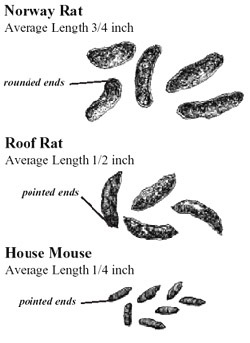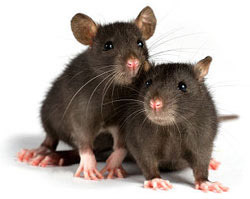Tips for a Rodent

If you’ve heard gnawing, squeaking, or scampering recently in your home. You probably have a house guest, a common mouse. Other rodents make their way inside, but distinctive characteristics of mice include gnaw marks on wood, plastic, or cardboard; fecal droppings 1/8 to ¼ inch long; musky odor; or body run marks along baseboards or insulation (Run marks are left behind by the dirty, oily body of a mouse repeatedly running back and forth along an established trail).
mouse in bread It is important to rid your home of these uninvited guests and ensure that your home is not hospitable or easily accessible to them in the future. House mice are not pets. Mice transmit diseases, cause fires by chewing electrical wiring, and mice ruin food, papers, storage boxes, woodwork, and insulation with gnawing, urine, and droppings. Pro-MAx Pest Control is an expert in the extermination of these unwanted house guests. We have years of experience and know just what to do to get the job done right the first time around! We’ve put together some important information on mice and rodents for you below.
Identify Your Problem
To begin eliminating your rodent problems, start with a good inspection. Inspecting your home, shed or barn is important for determining which type of rodents are present: rats or mice. A good inspection provides three main valuable pieces of information:
- Type of Infestation
- Extent of Infestation
- Location for Control Effort
- types-of-rodents
Droppings
Fecal pellets are the most commonly encountered sign in a rodent inspection and serve as primary evidence to confirm an infestation. Even a small population of mice can produce literally thousands of droppings in a short period of time. Examining the droppings can serve as evidence of an infestation and may help you identify your type of infestation.
rodent droppingsType of Infestation
House Mice

Quantity: 50 to 75 pellets daily
Size: ¼ inch long
Shape: Small with 1 or both ends pointed
Norway Rat
Quantity: 40 to 50 pellets daily
Size: ¾ inch long
Shape: Larger, rectangular with blunt ends
Found in small groups
Roof Rats
Quantity: 40 to 50 pellets daily
Size: ½ inch long
Shape: Larger, curved, sausage-shaped with pointed ends
Found scattered
rodent problem swflAge of Droppings
Fresh droppings are dark in color and soft in texture, but after three days they harden and lose the dark color. Age of droppings will tell you if your rodent problem is current.
Size of Infestation
This one is pretty simple – the more droppings you have…the larger your infestation, which will help you determine your approach for rat control.
Rodent Prevention Tips –
As far as your home is concerned, mice and rats look for the basics: food, water and shelter. Below are a few tips to rodent-proof your home and keep these annoying critters from thinking your home is their home.
Mouse Infestations SWFLRemove food & water sources

Cover trash cans with snug, metal lids (mice can gnaw through plastic).
Store pet & bird food in tightly sealed glass or metal containers.
Elevate your compost container at least 1 foot off the ground.
Pick up around fruit trees so fallen fruit or nuts don’t remain on the ground.
Clean up your garage tightly contain lawn seed, tulip bulbs and bone meal.
Remove opportunities for shelter
Inspect your house for broken windows, damaged sills or siding and foundation cracks.
Seal or screen over gaps around pipes and stove, dryer and foundation vents.
Install flashing to keep pests from climbing up your siding and getting into the attic.
Eliminate hiding places by removing ivy, trimming shrubs and bushes off the ground and away from the home foundation and elevating firewood.
Free Quote Extermination
A lot of devices and poisons have been introduced in order to exterminate rodents, but some of these may pose more problems in the future. To ensure complete victory over mice and rodents, you should hire an exterminator, such as Pro-Max Pest Control, to get rid of mice. We know everything about house rodents and the proper and effective ways to get rid of them for good!
Once you have rid your home of rodents, clean up around the house. A clean home is a less hospitable environment. Use plastic storage crates instead of boxes. Take newspapers to the recycling bin on a weekly basis. Keep woodpiles away from the house. Keep brush and debris swept, raked and cleaned. If your home looks like a mouse nest, it may very well be one.
Whether you currently have rodents or you want to protect your home against them, follow the tips included above and you’ll improve your chances of being rodent.

